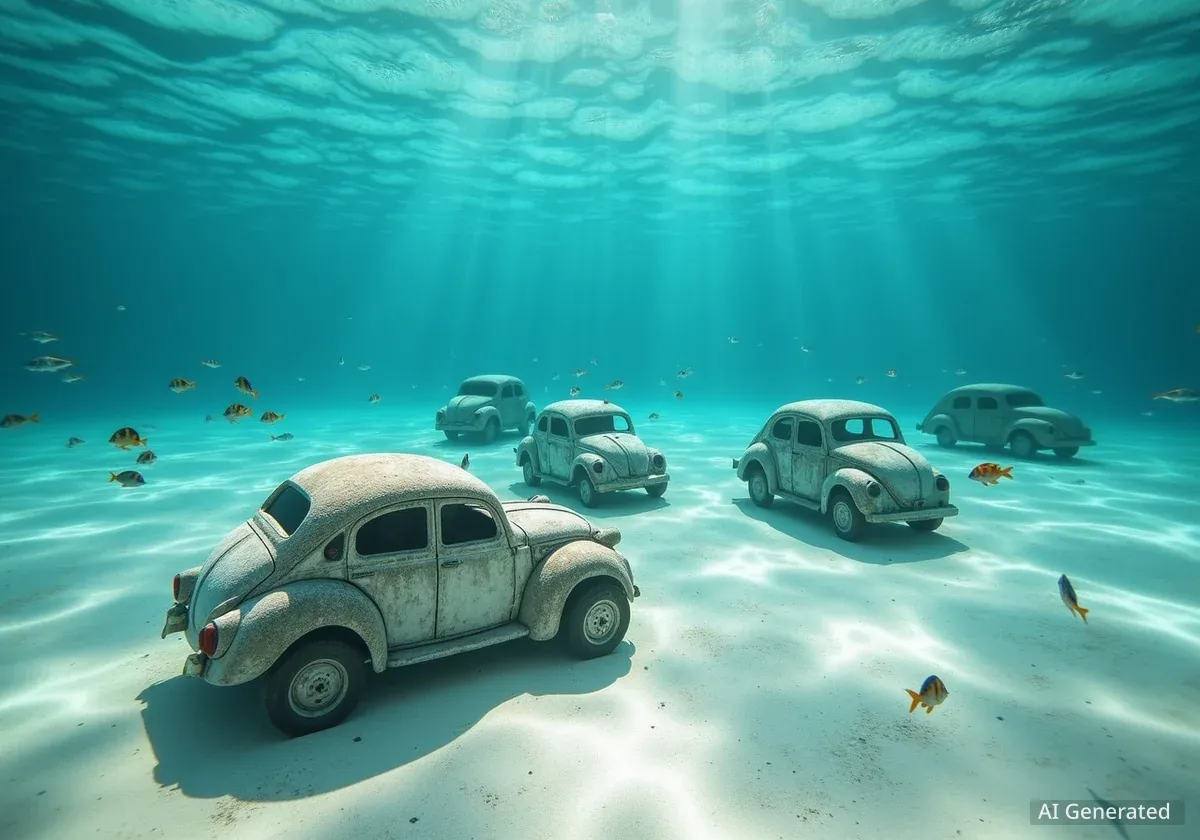An ambitious project combining art, science, and marine conservation has taken shape off the coast of Miami Beach, where 22 life-sized concrete cars have been submerged to form the first phase of a new artificial reef. The installation, known as the ReefLine, aims to restore marine habitats and promote coastal resilience.
The sculptures, designed by artist Leandro Erlich, were carefully lowered into the ocean late last month. They now rest approximately 800 feet from the shore at a depth of about 20 feet, creating a surreal underwater traffic jam that will soon become a foundation for new coral life.
Key Takeaways
- An underwater sculpture park called the ReefLine has been installed off Miami Beach to function as an artificial coral reef.
- The first phase features 22 concrete car sculptures designed by artist Leandro Erlich.
- Scientists will plant 2,200 native corals, grown from survivors of a recent marine heatwave, onto the structures.
- The project aims to boost marine biodiversity, create ecotourism opportunities, and serve as a model for coastal conservation.
Art Meets Marine Biology
The ReefLine is the creation of the nonprofit organization of the same name, founded by Ximena Caminos. She developed the concept with architect Shohei Shigematsu to create a unique intersection of public art and environmental science. The goal is to build a thriving marine ecosystem along a seven-mile underwater corridor.
"I think we are making history here," said Caminos. "It’s one of a kind, it’s a pioneering, underwater reef that’s teaming up with science, teaming up with art."
The project's first installation, titled "Concrete Coral," is more than just an art piece. The 22 car sculptures are made from marine-grade concrete, providing a durable and stable structure for corals to attach and grow. This initiative is designed to accelerate the natural process of reef formation.
Cultivating a Resilient Ecosystem
The scientific component of the project is critical to its success. Colin Foord, who manages the ReefLine's coral lab in Miami, is preparing to seed the underwater installation with 2,200 native corals. These are not just any corals; they are special survivors.
The gorgonian corals selected for the project were grown from fragments that survived the severe 2023 marine heatwave, which caused widespread coral bleaching across Florida. This genetic resilience gives scientists hope that the new reef will be better equipped to handle future temperature increases.
Foord explained that the team will soon begin the planting process, creating a vibrant forest of soft corals on the submerged vehicles. This will transform the static sculptures into a dynamic habitat for fish and other marine creatures.
"Nature’s gonna take back over, and we’re helping by growing the soft corals," Foord stated. He believes the artistic concept of a submerged traffic jam enhances the message of nature reclaiming human-made objects.
A Vision for the Future
"Concrete Coral" is just the beginning. The ReefLine is planned as a multi-phase project, with future installations already designed by other internationally recognized artists. These include:
- "Heart of Okeanos" by Petroc Sesti, a sculpture modeled after the massive heart of a blue whale.
- "The Miami Reef Star" by Carlos Betancourt and Alberto Latorre, which will feature a collection of starfish shapes arranged in a larger star pattern.
These future additions will continue to expand the artificial reef, providing more complex structures to support a diverse range of marine life. "What that’s going to do is accelerate the formation of a coral reef ecosystem," Foord added. "It’s going to attract a lot more life and add biodiversity."
Funding and Community Support
The initial phase of the ReefLine is partially funded by a $5 million bond from the City of Miami Beach. The nonprofit is actively fundraising to secure an additional $40 million to complete all 11 planned phases of the ambitious project.
Economic and Educational Impact
Beyond its environmental benefits, city officials expect the ReefLine to become a significant local asset. Miami Beach Mayor Steven Meiner anticipates that the underwater park will generate jobs and boost the local economy through ecotourism.
The site's accessibility—located just a few hundred feet offshore in relatively shallow water—makes it ideal for activities like snorkeling, diving, kayaking, and paddleboarding tours. This provides a new attraction that highlights the region's natural environment rather than just its bustling city life.
"Miami Beach is a global model for so many different issues, and now we’re doing it for ReefLine," Meiner said at a recent ceremony. "I'm so proud to be working together with the private market to make sure that this continues right here in Miami Beach to be the blueprint for other cities to utilize."
The project also includes a strong educational component. The organization offers community programs where volunteers can work alongside scientists to plant corals. A floating marine learning center is also planned to provide hands-on experience in coral conservation.
While acknowledging that an art installation cannot single-handedly solve global issues like climate change, founder Ximena Caminos hopes it will spark important conversations. She sees the ReefLine as a powerful symbol of human ingenuity applied to environmental challenges.
"We can show how creatively, collaboratively and interdisciplinarily we can all tackle a man-made problem with man-made solutions," she concluded.
